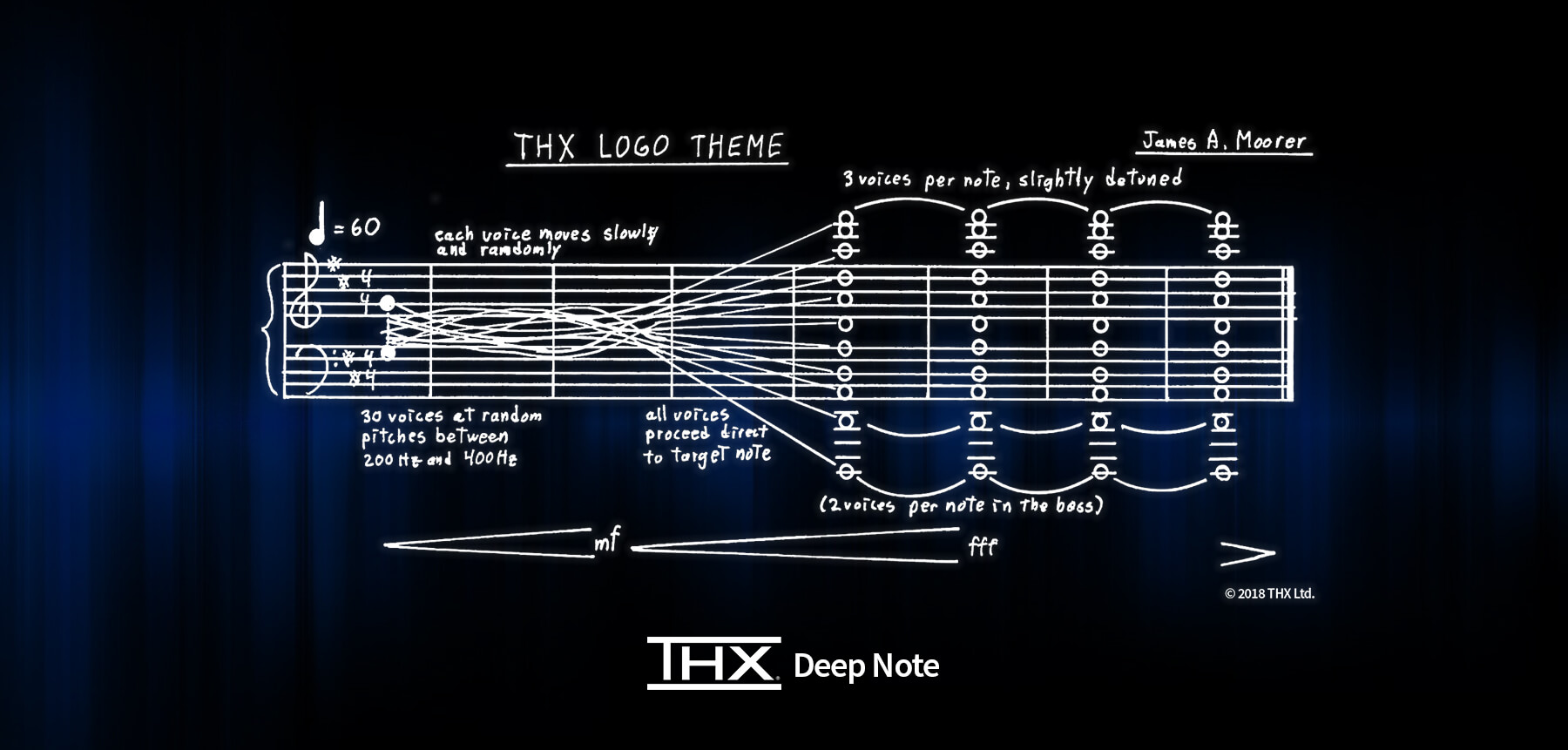If you've been to the cinema anytime since 1983 you may have encountered the THX logo telling you that your cinema is THX certified and the audio experience you are about to hear will be incredible. The three letter logo is one thing, but the accompanying audio logo sound, known as the Deep Note is unforgettable. The famous note was composed by Lucasfilm sound engineer Dr. James 'Andy' Moorer the logo was first screened at the start of the 1983 premiere of Star Wars: Episode VI - Return of the Jedi.
The U.S. trademark registration for the first version of the sound contains this description of it:
The THX logo theme consists of 30 voices over seven measures, starting in a narrow range, 200 to 400 Hz, and slowly diverting to preselected pitches encompassing three octaves. The 30 voices begin at pitches between 200 Hz and 400 Hz and arrive at pre-selected pitches spanning three octaves by the fourth measure. The highest pitch is slightly detuned while there are double the number of voices of the lowest two pitches
I have used the THX Deep Note many times in theatre situations as a way of assessing the acoustics and audio capabilities of the installation.
THX Deep Note chordal composition
History
In 1980 George Lucas wanted the best sound system possible for the premiere of his latest Star Wars film, The Empire Strikes Back.
The usual sound systems of the day comprised left, centre and right speakers behind the screen and an additional surround speaker. When his engineers investigated one of the old Majestic cinemas in San Francisco they were horrified to find that of the three speakers behind the screen one was disconnected, one had fallen over and the other was turned around backwards. The decision was taken to come up with a standard to ensure that cinema sound quality was as good as it was in the film mixing suites. George used his power to insist that any cinema that wanted to show his films needed to become THX certified.
Dr. Andy Moorer had already spent two years designing and programming a computer that was powerful enough to deal with the mathematics needed to create rich natural sounds which were more than the bleeps and bloops of the Ataris of the day, so it was natural for him to use his work when he was asked to create the THX sound.
What is THX certification?
The THX certification does not concern any encoding of decoding of the sound itself. It covers the following 4 areas:
Auditorium - isolation between auditoriums, interior acoustics, background noise requirements (air conditioning, projector)
Equipment - speakers, amplifiers, projectors
Configuration - where is the equipment placed
Calibration - testing that a cinema meets the THX requirements
The THX Sound
The sound starts with chaos and rises to a huge chord, similar to the sound produced by large pipe organs. When developing the sound Andy was influenced by Bach fugues and the end of A Day in the Life by The Beatles.
The first Deep Note was generated using random numbers meaning that each time it was played from the computer it was slightly different. Every second each of the 30 voices was assigned a new pitch to work towards until the point when they were given their final target pitch resulting in the final chord. Each note is slightly detuned to give the final chord its fullness. The tuning used is not equal temperament (each of the 12 notes being equally spaced) but uses Pythagorean tuning (used around the middle ages but doesn't easily facilitate key changes)
Listener reaction
Thomas Dolby describes the sound as:
a sound emerging from the primordial soup of molecules of carbon and water vapour and ether. By alchemy, these are brought together into this pillar of the final chord. It's like building structure from chaos.
Others have said:
the THX logo is the single most terrifying thing ever.
The THX audio logo has become so well known that there have been several other versions made for TV and film.
James A. Moorer said in a 2005 interview:
I like to say that the THX sound is the most widely-recognized piece of computer-generated music in the world. This may or may not be true, but it sounds cool!
Innovation
Two new versions were produced but neither were successful.
In 2015 THX decided to produce a new version of the original using new state-of-the-art equipment.
Andy re-coded the entire program using the C language and because of computer advances he was now able to run it on his home computer. He developed alternative versions using more voices for the different cinema setups. The standard stereo version still used 30 voices but for 5:1 he used 40 voices, 7:1 used 60 and 9:1 used 80. The sound also now moves spatially around the room.
Joseph Rapisardi has recently done an approximation of the Deep Note on a Behringer Neutron
